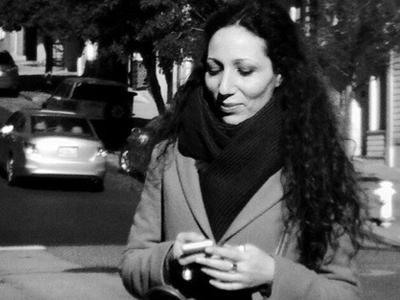Bernhard Schobinger — Annelies Štrba
April 20–June 29, 2024
Antonella Villanova Galleria, Florence, Italy
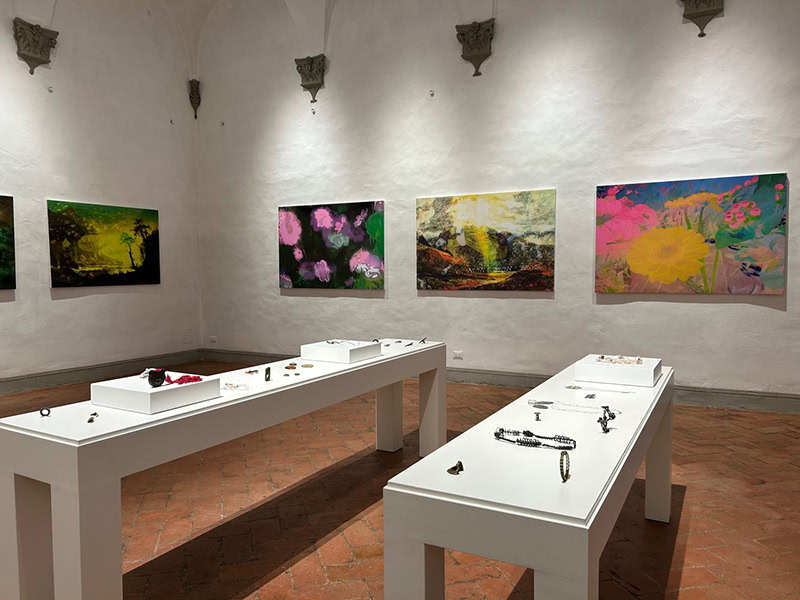
From the moment I left Antonella Villanova Gallery, I told myself that I shouldn’t wait too long to put in order, and on paper, my thoughts and the multitude of stimuli I received during my visit and intense chat with Bernhard Schobinger. Together with his wife and life partner, Annelies Štrba, he was in Florence for the opening of their double solo exhibition at the Antonella Villanova and Alessandro Bagnai galleries.
The variety of Schobinger’s spontaneous narratives allowed a fruitful dialogue and a natural connection with his work. It confirmed the intense and layered complexity of a sui generis creator who has maintained rigorous faith, over time, in his purest and most genuine instinct. It has led him to follow his talent and develop an extraordinary language.
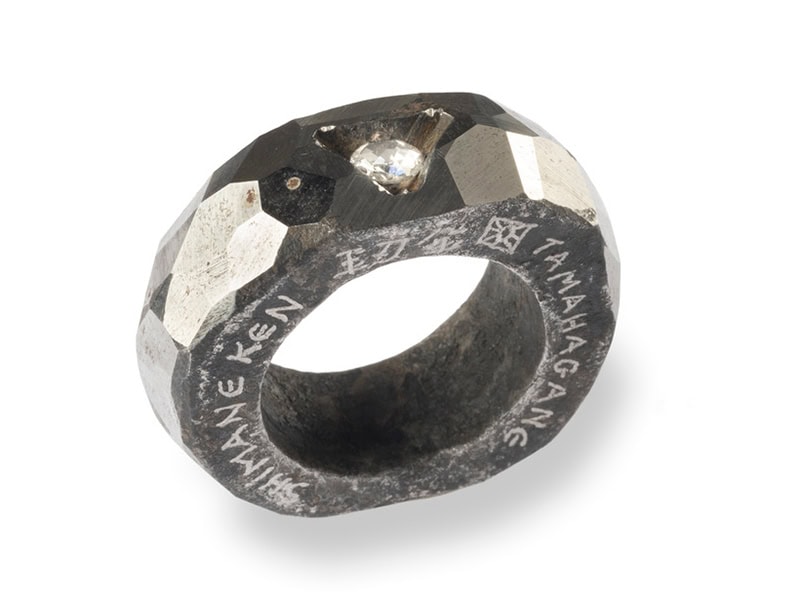
The exhibition retraces much of his artistic career, which spans the last 30 years of the 20th century to the present day. It has nourished itself on the cultures and subcultures of the period, originating from concretism and then developing in the punk culture of the 70s, in Italian Arte Povera, and in neo-Dadaism.

Schobinger subverts and converts balances and customs by making rebellion against conventions and aesthetic canons his approach to life. Far from being a dogma, this becomes a spontaneous action in his way of relating with found objects, family memories, and materials. This constant rebellion against ordinariness and habits, mediocrity, against the ineffable passing of time and toward commodification, deeply undermines those places where the certainties and comfort of homologation, of the pre-constituted and the pre-packaged, reside.

Making his own natural, intimate, and familiar environment the inexhaustible source of stories and visions, Schobinger composes and recomposes as a primordial and instinctive act of ordering chaos and subverting the traditional concepts of aesthetics, in particular linked to the canonical codification of jewelry and ornament.
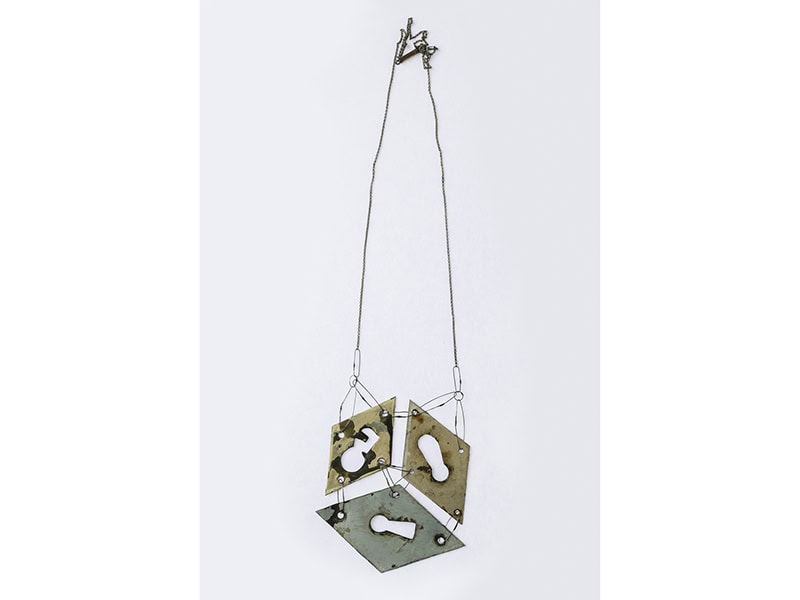
The pieces on display offer a compendium of the incredible variety of languages and expedients with which the artist has expressed himself over time. He always plays openly with the irony of compositional contrasts. For example, he combines the warmth of the remembrance of family objects, bearers of memories and affections, with the coldness of recycled materials, often raw and unprocessed metals. Or he alternates preciousness with the ordinariness of the components, expertly balanced in compositions of refined features and technique.
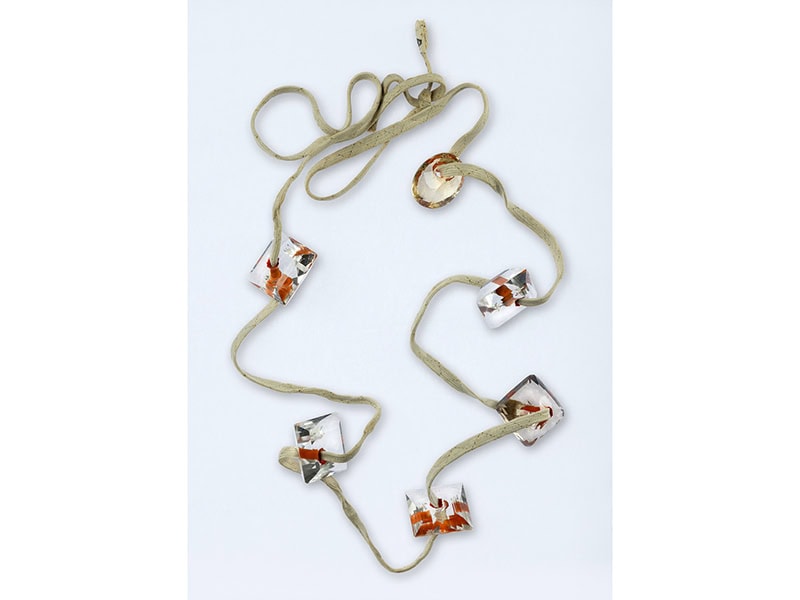
Sometimes he prefers animistic vitality and concentrates on creating the illusion of faces, little eyes, anthropomorphic features, on found objects, as in the case of Face Brooch (1997) or Taddybar/Huhn/Anhanger (2002), or, again, the more recent and courtlier Necklace for Erica Bloom (2018). Works such as these generate a typical suspension of the enigma and the uncanny, of elsewhere.

The polarity through which that perfect tension that attracts and captivates in his works materializes is given by the dialectic between play and danger, between irony and drama, between pleasure and pain. It is in this dynamic relationship that his most authentic stylistic signature finds expression, the originality of a compositional thought that is never predictable and always generative.

We find it, for example, in perhaps the oldest work on display in the exhibition (shown directly above), an untitled steel and gold necklace with an abstract and geometric design. It refers to the shape of an animal, in a past life probably a work tool, today a pendant that orients a serrated and sharp profile toward the base of the neck. The same perception comes from the works that present sharp or imperfect profiles, made of metal, ceramic, and often glass. One also sees them through the explicit reference to danger warnings, such as the poison bottles used for glass necklaces and bracelets, with the drawings of a skull, symbol of death.
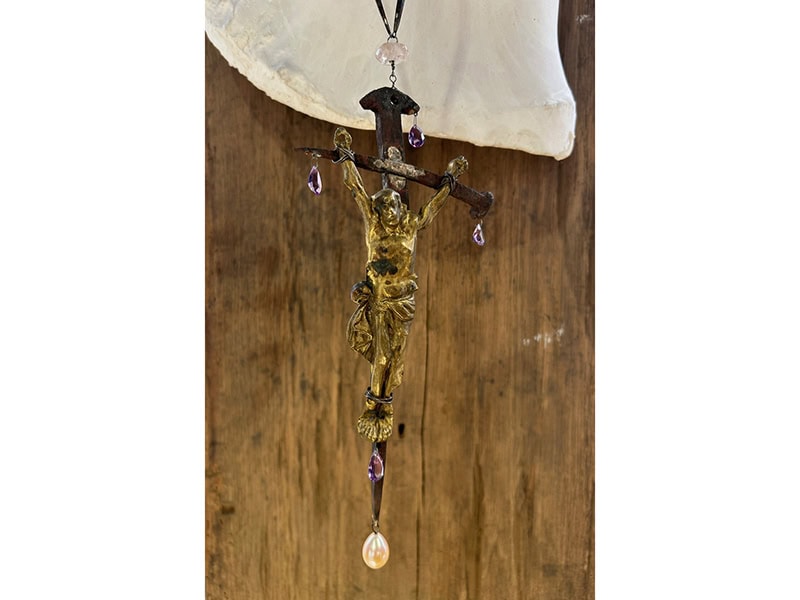
In Kruxifiux mit Nageln (2014), the use of nails, in the body of the cross itself, similarly recalls the very idea of crucifixion, opening to the sacral dimension as a further stylistic stratification of its rich symbolic universe. This tragic nature of life is always counterpointed by an element of relief, irony, fun. The skulls, for example, in the Skulls necklace (2016), are crowned by a small sequence of beads that pleasantly decorates their foreheads. In another piece, Hand mit Zweig Goldring (2006/2018), a doll’s arm nostalgically grasps a microphone made of coral and Tahitian pearl.
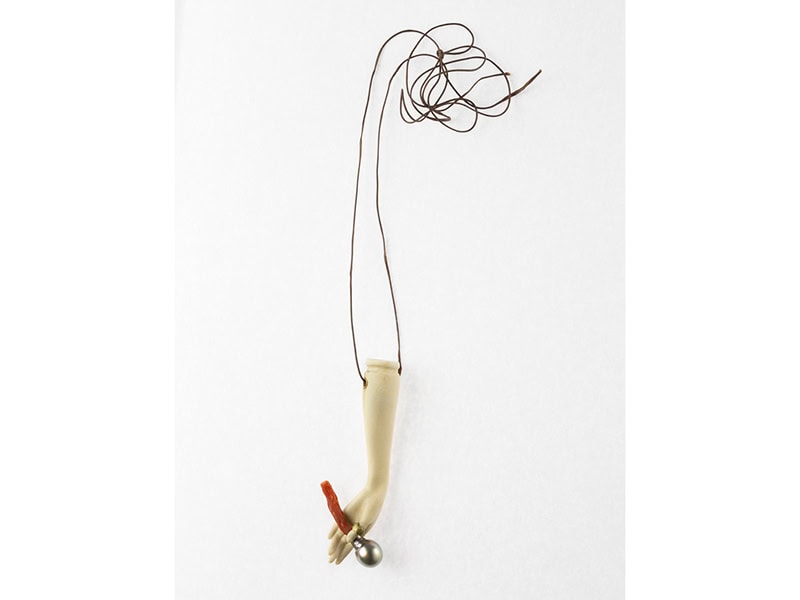
Schobinger embodies the mythological figure of the demiurge, without whom it is impossible for anything to have a birth. The demiurge is not strictly a generator god like the Christian one, but rather an ordering demigod: he gives the breath of life to a formless and ungenerated matter that pre-exists him. Artificer and father of the universe, the demiurge is, in the Platonic myth, an ordering, imitating, shaping force that vivifies matter, giving it a form, an order.

In Schobinger’s case, we could also say “a demiurge who laughs,” who sneers nihilistically while also making a little fun of humanity, all busy trying to find meaning in life.
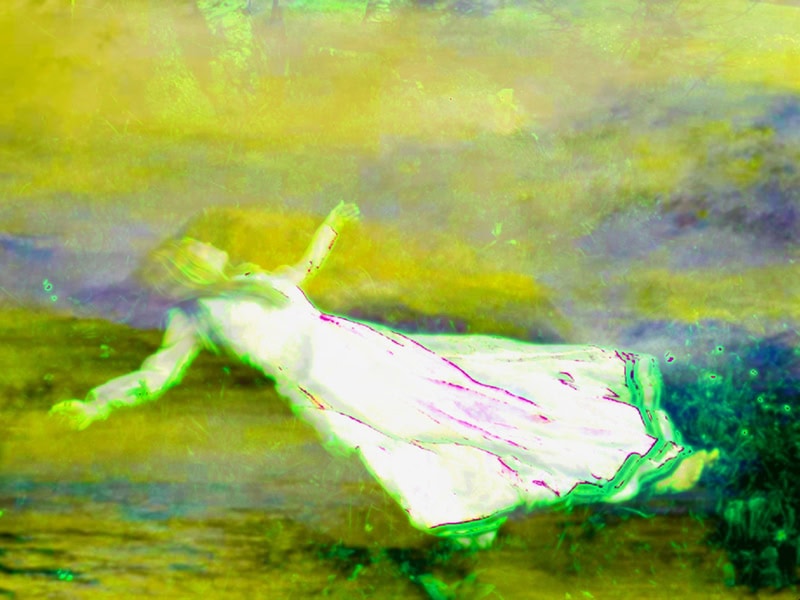
The exhibition is enriched by the photographic work of Annelies Štrba, who has shared a human and artistic partnership with Schobinger since the 1970s. The female figure and surrounding nature are the focal point of her visionary and dreamlike work, saturated and imprinted in photographic prints on canvas, which, as Emanuela Nobile Mino excellently points out in Antonella Villanova Galleria’s press release, “merge with themes linked to visual and literary culture developed between the 19th and 20th centuries, from which the artist draws iconographic subjects, such as the famous Ophelia by John Everett Millais, or linguistic references, such as the lyrical decorativism of Pre-Raphaelite painting or the esotericism of the Symbolist current.”
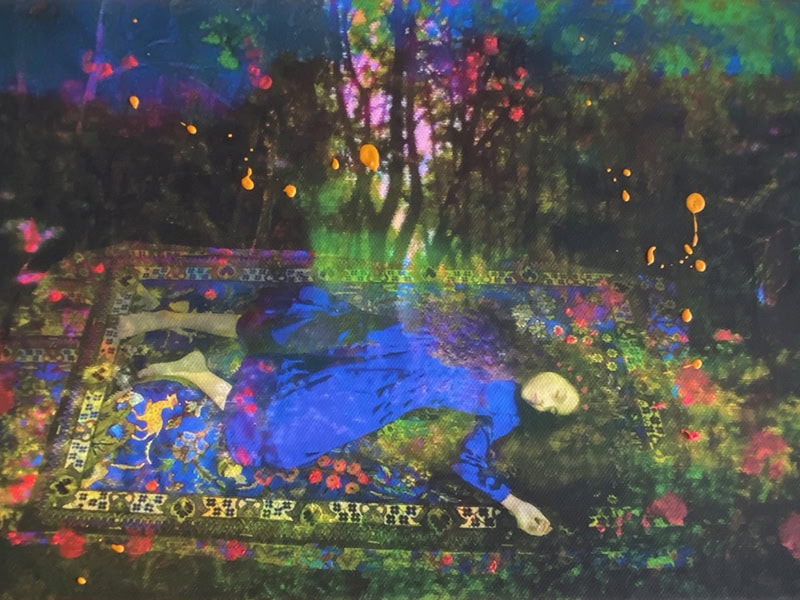
Both artists speak to us of traces and reminiscences of life and death, of transcendence and sacredness that nestles in the body of materials and light.
This is an important exhibition for Antonella Villanova, who has been curating Schobinger’s work for years in Italy and abroad. With courage and decision, she represents that artistic and innovative dimension around the language of ornament without compromise or accommodation, through a pioneering activity at international quality events such as Design Miami or Nomad, in St. Moritz.
Visit Antonella Villanova Galleria’s exhibition page here.
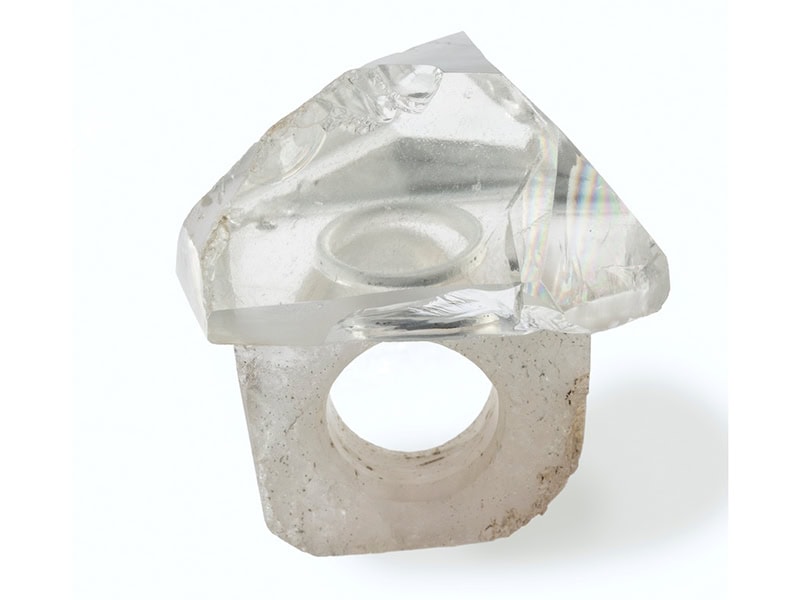
Reviews are the opinions of the authors alone, and do not necessarily express those of AJF.
We welcome your comments on our publishing, and will publish letters that engage with our articles in a thoughtful and polite manner. Please submit letters to the editor electronically; do so here.
© 2024 Art Jewelry Forum. All rights reserved. Content may not be reproduced in whole or in part without permission. For reprint permission, contact info (at) artjewelryforum (dot) org
